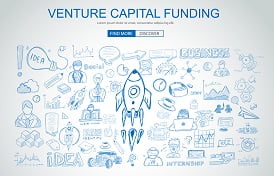When it comes to pitching investors, it’s vitally important to know how, what, and when, to pitch. Venture Capitalists, or VC’s, are some of the most savvy investors on the planet. This group of highly educated investors looks for top-tier companies to invest their money into, typically reaping a handsome reward at some point during the investment; moreover, they’re willing to wait for the payoff. For example, Bill Gurley, from Benchmark says “Venture capital is not even a home-run business. It’s a grand-slam business.” The business of venture investing has seen a 42% increase in capital raised, thus it is imperative that companies pitch to VC’s. Getting in front of the right VC’s, then pitching properly, is another matter altogether. See Medium.
VC’s can get involved on many different levels, e.g., seed rounds, series A, B, or C. Firms like the renowned Kleiner Perkins look for specific types of deals, at all ends of the spectrum, but they lean toward investing in “unicorns,” or companies that have successfully disrupted a market and have a clear path toward a Return On Investment, or ROI. However, Kleiner Perkins is no longer the only game in town. Knowing this data, entrepreneurs can start to develop their pitches for the appropriate audiences. How does one prepare for a number of different VC audiences? Ideally, they would prepare a few different pitches, but most can successfully pitch by finding a middle ground.
………………………………
Let’s take, for example, a software development company that focuses on real estate brokers. First, they would need to obtain a verifiable list of VC’s who are known to invest in real estate software companies. Second, they need to research the partners in the VC firm, locating where each partner went to college, what areas of the world they come from, and other particular background information. Next, they’ll use the partner backgrounds to start developing their pitch, catering it to the partners.
1. Expectation-Setting
Setting up the audience, give them a quick synopsis of what they can expect from your pitch, your product, and your team. This should a quick 2-3 minute overview. Give them just enough information to create an appetite for the pitch, for example, a software company would discuss how their software fills a void in the market, and what types of revenue and profits they expect to see.
2. The Flow of Your Presentation
- The point of pitching is to earn the respect and credibility of the VC. Spend the first 25% of your pitch establishing who you are, who your team is, and why your product is the next best market idea.
- The second 25% should be digging into the details of why the customer needs your product. Define your customer, break down the demographic into specific terms, and give the VC a reason to take notice of your niche.
- Give the next 25% to explain how your product works, why it’s important, how profits are made, and where you foresee the growth of the product; moreover, where you anticipate the market going.
- Finally, spend the remaining portion on financial data. How will your balance sheet look year-over-year, what will the P&L look like, and how will the investors reap a profit. Moreover, briefly discuss a potential investment structure, if for nothing else, to show the VC that you’ve put some thought into a structure.
- Don’t jump around in your presentation. Flow in chronological order using the Pitch Deck (see below).
- Don’t move at light speed. Give your audience enough time to absorb the information and formulate questions.
3. Your Opening Statement
Give your audience a concise and convincing overview. It should include the following elements: (1) an introduction, (2) a body, which includes a story about your product and how it inspired the creation of your idea, and (3) a conclusion. In the scenario we used above the software company may open with something like:
“My name is Mr. Entrepreneur, and I’m a recent graduate of the Harvard College of Computer Sciences. Twelve months ago I was buying a house and after talking to my broker realized that the property I was interested in wasn’t listed in his MLS directory, and he complained that someone should come up with a way to automatically bring in this data for his agents. I then wrote a software program to solve the problem and the broker bought it for $5,000. That was my first sale, and now I’d like to make the software mainstream. That’s why I’m here, to include you in my quest, and to earn some profits while doing so. Let’s work together to make my idea ubiquitous.”
4. The Pitch Deck
- Cover Page – you’ll need to catch their attention from the onset. Boldly display your branding;
- Elevator Pitch – two sentences that describe your business model completely;
- About Us – a short, concise explanation of who your company is;
- Vision – what is your vision for the brand and the company;
- Mission Statement – a paragraph detailing your mission for the company;
- Milestones – explain, in short blurbs, your key milestones;
- Company Structure – Describe your teams, and how they fit within the company;
- Timeline – detail your time-to-market. How long will it take to get your product into the hands of consumers, reach profitability, expand, and go public?
- Customers’ Pain – what does the customer want, that they’re not getting?
- Problem – explain the problem the customer, or the market, has;
- Solution – give the customer a solution to the problem;
- Conversion – how does the sales process convert viewers, or visitors, into customers;
- Market Size – how large is the market for your product or service;
- Market Growth – how fast will the market grow, and is it sustainable;
- Product or Service – layout your product or service in short, concise blurbs;
- Revenue Model – how does your revenue model work?
- Competition – who are your major competitors? What are their strengths and weaknesses?
- Product Pricing Model – layout your pricing in short concise boxes or circles;
- Team – who is on your team? List each member of executive management, include their highlights;
- Metrics – list key metrics for sales and internal operations;
- Use of Proceeds – what do you plan to use the money for? Give 4-5 key points;
- Financials – a short and concise P&L; and
- How to Contact You – be sure to list all communication preferences, phone, email, etc.
5. Your Closing Statement
Close the deal! You can’t successfully receive the financing without giving a convincing reason for the VC to write you a check. The elements of a good closing statement include: (1) restate your expectation-setting, (2) support your idea with facts about your customer’s needs, and how your product fills the need, (3) go over the ROI and how you foresee the exit plan working, and (4) state your name, and contact information. Using the software company example, you could say:
“In closing I’d like to reiterate how the real estate industry has a large void in the delivery of data to local brokers. My team and I have discovered a unique niche and have developed software to alleviate the problem. We have monetized the product into a SAAS, allowing brokers to keep the most up-to-date listings and this works in all markets across the country, with the potential to reach over 50 million American home buyers and sellers. To get this revolutionary product to market we need $50,000,000, and we’re prepared to provide a unique exit for you from the investment, provided the exit is lucrative for all stakeholders. Again, my name is Mr. Entrepreneur, and I can be reached at 555-555-5555, or at [email protected].”
6. Extra Credit
It’s easy to get overwhelmed when preparing for a pitch, so we recommend getting plenty of sleep the night before, as well as, a good meal. Be sure to hit only the highlights of your information. Avoid getting into too much detail with this pitch, unless they ask for details. If you peek their interest, they will ask for a more detailed version of your business plan.

